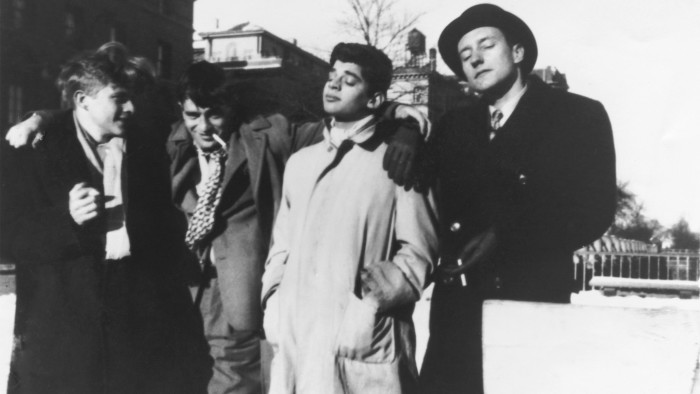‘The Haunted Life: The Lost Novella’, by Jack Kerouac

Simply sign up to the Life & Arts myFT Digest -- delivered directly to your inbox.
The Haunted Life: The Lost Novella, by Jack Kerouac, Penguin Classics, RRP£20, 208 pages
Jack Kerouac, an author who was barely patient enough to punctuate his sentences, never mind sit still in one place, always claimed that he had lost the manuscript to his early novella The Haunted Life in the back seat of a yellow taxi cab. The truth is less dramatic: he probably forgot it in the closet of a Columbia University dorm room that had belonged to his fellow Beat writer Allen Ginsberg.
It resurfaced in a Sotheby’s auction 12 years ago, selling to an unnamed bidder for $95,600. The previous year, Kerouac’s most renowned manuscript, the famous On The Road scroll, had also sold at auction for a whopping $2.4m, which explains the sudden appearance of the earlier work.
Those relative values strike me as well-judged. The Haunted Life, now published for the first time and generously annotated and edited by Kerouac scholar Todd Tietchen, is a minor addition to the author’s corpus but not without interest. Kerouac wrote it at the age of 22, in the turbulent year of 1944, during which he was jailed as an accessory to murder, married his first wife Edie Parker to secure bail, and was then released.
“I should now have material for a fine book . . . love, murder, diabolical conversations, all,” he wrote mischievously, but none of these promising themes finds its way into A Haunted Life. Instead we get a rehearsal for the semi-autobiographical exploration that would form the basis of Kerouac’s first major published work, The Town and the City.
Tietchen, in his introduction to the novella, believes that this early and methodical exposition of the author’s literary intentions is a significant rebuttal of the “public perception of Kerouac as a spontaneous word-slinger whose authorial approach merely complemented his Dionysian approach to life”. He casts the hedonistic writer as an improbable respecter of process, honing his ideas in this brisk workout.
In A Haunted Life, Kerouac’s concerns are refracted through Peter Martin, heading into his sophomore year at Boston College along with his friends Garabed Tourian and Dick Sheffield, based on the author’s real-life buddies Sebastian Sampas and Billy Chandler, both of whom had died in the war by the time Kerouac wrote the novella.
The three young men’s conversations skirt around some of the issues that preoccupied American intellectual life in the 1930s and 1940s: the end of the Great Depression, the US’s entry into the war, the exploitation of the working classes, and the possibility of romantic escape from all of those needling dilemmas.
Garabed and Dick respectively represent the leftist and liberationist ideals that animated those debates. In contrast, Peter’s frosty exchanges with his father Joe – clearly based on Kerouac’s own father Leo – see the young man wrestling with the bigotry of the preceding generation. In the novella’s very first pages, Peter drowns out the beginnings of one of his father’s rants by turning up Benny Goodman on the record player, an early reflection of Kerouac’s belief that jazz music’s freedom of form was the nemesis of sclerotic social views.
This opening feels stagey, as do the opening remarks between Peter and Garabed, clunky in their philosophical intent: “Poor Garabed,” says Peter. “Dostoevsky terrifies you with his Slavic portraits that remind you too much of yourself. You fear ugliness, you chase beauty and embrace it.”
As we focus on Peter’s interior life, touches of the freewheeling Kerouac begin to emerge in passages of existential celebration: “The morning sun, the swift clean smell in the air had called him back to life, called him back for more of the same – which at times held so much wonder that Peter deplored his physical limits. On a morning like this! – to be everywhere, be everyone at the same time, doing everything!”
Kerouac always intended The Haunted Life to become a multi-volume saga on the war, told through the story of the Martin family. “[It] will be a very sad book,” he explains in a note included here. “It can’t be otherwise: youth is shocked by maturity, but war adds to this shock enough to kill youth forever.”
But it is not for this melancholy tone that Kerouac would become best known, and it is clear from his musings that he was already looking ahead at a new America. In an outline for The Town and the City, he emphasises that the book’s ending will treat its characters well. “I write with gravity and gleefulness because I do not feel sceptical and clever about these things, and I believe that this is an American feeling. (No Joyce, no Auden, no Kafka has anything to say to a true American.)”
With that slap at the Old World, Kerouac launched himself to become one of the most exuberant adventurers of a new cultural landscape, whose heroes would include James Dean, Marlon Brando, Elvis Presley, characters who were infused with a sense of the limitless. Here, in this small book, are the tentative beginnings of a journey that was always going to lead to the open road.
Peter Aspden is the FT’s arts writer
Comments